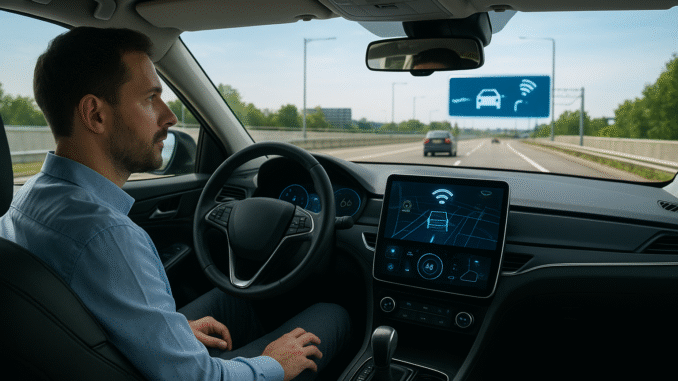
Smart Cars, Smarter Roads: How Technology Is Driving the Future of Automobiles
The automotive industry is undergoing a transformation unlike anything we have seen before. Gone are the days when innovation in cars meant just better engines, sleeker designs, or improved safety belts. Today, the industry is being reshaped by cutting-edge technologies like artificial intelligence (AI), the Internet of Things (IoT), autonomous driving systems, and smart infrastructure. Together, these innovations are giving rise to “smart cars” and “smarter roads,” creating a connected ecosystem that promises safer, more efficient, and more sustainable transportation.
In this article, we’ll explore how technology is driving the future of automobiles, the key features of smart cars, the development of intelligent road systems, and what this means for drivers, passengers, and society as a whole.
The Evolution of Smart Cars
Smart cars are vehicles equipped with advanced technologies that allow them to interact with drivers, other vehicles, and even the roads themselves. While many people associate smart cars with self-driving vehicles, the concept goes much deeper.
Modern smart cars come with features such as:
- Advanced Driver Assistance Systems (ADAS): These include lane-keeping assistance, adaptive cruise control, and automated braking that reduce the likelihood of human error.
- Connectivity Features: Cars can now sync with smartphones, provide real-time traffic updates, and even schedule maintenance automatically.
- AI Integration: Artificial intelligence powers voice assistants, predictive maintenance, and driving behavior analysis.
- Sustainability: Many smart cars are electric or hybrid, reducing emissions and promoting greener mobility.
This shift is making vehicles not just modes of transport but intelligent machines capable of enhancing convenience and safety on the road.
The Rise of Autonomous Driving
Perhaps the most revolutionary aspect of smart cars is autonomous driving. Companies like Tesla, Waymo, and legacy automakers are investing billions in self-driving technologies.
Autonomous cars use a combination of:
- Cameras and Sensors to monitor surroundings.
- Lidar and Radar for depth perception and object detection.
- AI Algorithms to make split-second decisions.
- Mapping Systems to navigate routes efficiently.
Levels of autonomy range from basic driver assistance (Level 1) to fully driverless cars (Level 5). While we’re not yet at widespread Level 5 adoption, pilot programs in cities across the globe show that driverless taxis and delivery vehicles are no longer science fiction.
The promise of autonomous driving is enormous: fewer accidents caused by human error, smoother traffic flow, reduced congestion, and better accessibility for those unable to drive.
Smarter Roads: The Next Step in Transportation
It’s not just cars that are becoming smarter—roads are, too. Smart roads are designed with sensors, cameras, and digital systems to communicate with vehicles and improve the flow of traffic.
Some innovations in road technology include:
- Connected Infrastructure
Traffic lights, street signs, and highways are being equipped with IoT devices to send real-time updates to vehicles. For example, cars can receive alerts about road hazards, construction zones, or slippery conditions ahead. - Wireless Charging Lanes
Certain experimental roads allow electric vehicles (EVs) to charge wirelessly while driving, solving one of the biggest challenges of EV adoption—limited battery range. - Smart Traffic Management
AI-driven traffic lights adjust their timing based on congestion, reducing idle times and lowering emissions. - Sustainable Materials
Smart road designs often incorporate eco-friendly materials, solar panels for energy generation, and noise-reducing surfaces.
Together, smart cars and smart roads form an intelligent ecosystem where vehicles communicate with infrastructure (known as Vehicle-to-Infrastructure or V2I communication). This integration makes driving smoother, safer, and more efficient.
How Smart Cars and Roads Work Together
The future of driving isn’t just about the individual car—it’s about the interaction between vehicles and their environment. Here are some real-world examples of this synergy:
- Accident Prevention: If a car detects sudden braking ahead, it can instantly share this information with nearby vehicles through V2V (Vehicle-to-Vehicle) communication.
- Navigation Efficiency: Smart traffic systems can reroute drivers in real time to avoid congestion.
- Energy Optimization: Electric vehicles driving on wireless charging roads won’t need frequent stops, making long-distance travel easier.
- Weather Adaptation: Smart roads equipped with temperature sensors can alert vehicles to icy patches, reducing the risk of accidents.
This network effect will redefine mobility, making every trip safer, quicker, and more sustainable.
Benefits of Smart Automotive Technology
The shift toward smart cars and smarter roads brings a range of benefits:
- Enhanced Safety: With advanced sensors and AI, vehicles can prevent collisions and reduce fatalities caused by human error.
- Reduced Traffic Congestion: Smarter traffic systems and autonomous cars that coordinate with each other can ease congestion in busy cities.
- Environmental Sustainability: Electric smart cars, combined with efficient road designs, help reduce carbon emissions and pollution.
- Improved Accessibility: Autonomous vehicles can provide mobility solutions for the elderly and disabled, fostering inclusivity.
- Economic Efficiency: Less fuel consumption, optimized routes, and fewer accidents mean significant savings for individuals and governments alike.
Challenges to Overcome
While the vision of smart cars and roads is promising, several challenges must be addressed:
- High Costs: Building smart infrastructure and manufacturing advanced vehicles require massive investment.
- Cybersecurity Risks: Connected vehicles are vulnerable to hacking, making security a top concern.
- Legal and Ethical Issues: Questions remain about liability in case of accidents involving autonomous cars.
- Adoption Barriers: Some consumers are hesitant to trust driverless technology, and governments must update regulations to support innovation.
- Digital Divide: Not all regions can afford or support the technology, creating inequality in access.
Addressing these challenges will require collaboration among automakers, governments, and technology companies.
The Road Ahead
Looking forward, the integration of smart cars and smart roads is not just a technological upgrade but a societal transformation. Cities of the future may have fewer accidents, cleaner air, and more efficient transportation systems thanks to this revolution.
Automakers are racing to innovate, while governments are investing in smart infrastructure projects to prepare for this shift. The next decade could bring widespread adoption of semi-autonomous vehicles, connected roadways, and a complete rethinking of how we commute.
The dream of seamless, safe, and sustainable transportation is closer than ever. What once seemed futuristic is now becoming reality—thanks to the marriage of smart cars and smarter roads.
Conclusion
The future of automobiles is being defined not just by powerful engines or sleek designs, but by intelligence, connectivity, and innovation. Smart cars, combined with smart roads, are creating a new era of mobility—one where safety, efficiency, and sustainability take center stage.
As technology continues to evolve, drivers and passengers alike can look forward to a transportation system that isn’t just about getting from point A to point B, but about doing so in the smartest way possible.
The journey toward smart cars and smarter roads is already underway, and it’s driving us toward a future where every mile traveled is safer, cleaner, and more connected.

